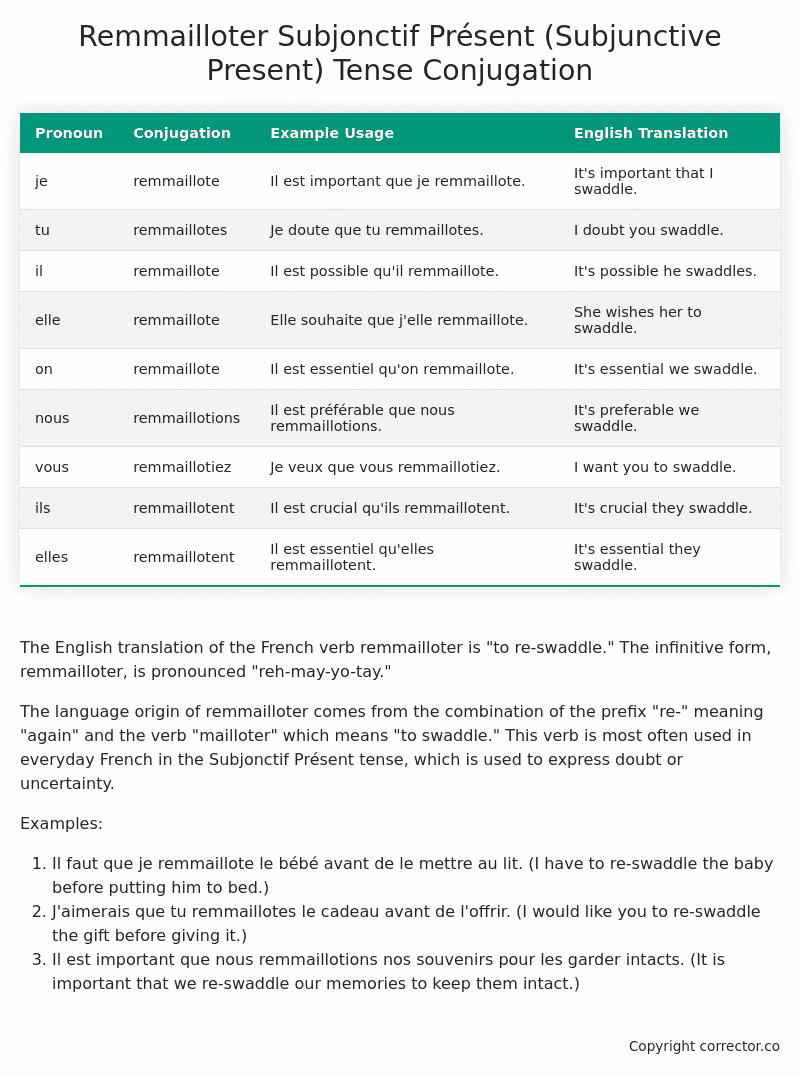Subjonctif Présent (Subjunctive Present) Tense Conjugation of the French Verb remmailloter
Introduction to the verb remmailloter
The English translation of the French verb remmailloter is “to re-swaddle.” The infinitive form, remmailloter, is pronounced “reh-may-yo-tay.”
The language origin of remmailloter comes from the combination of the prefix “re-” meaning “again” and the verb “mailloter” which means “to swaddle.” This verb is most often used in everyday French in the Subjonctif Présent tense, which is used to express doubt or uncertainty.
Examples:
- Il faut que je remmaillote le bébé avant de le mettre au lit. (I have to re-swaddle the baby before putting him to bed.)
- J’aimerais que tu remmaillotes le cadeau avant de l’offrir. (I would like you to re-swaddle the gift before giving it.)
- Il est important que nous remmaillotions nos souvenirs pour les garder intacts. (It is important that we re-swaddle our memories to keep them intact.)
Table of the Subjonctif Présent (Subjunctive Present) Tense Conjugation of remmailloter
| Pronoun | Conjugation | Example Usage | English Translation |
|---|---|---|---|
| je | remmaillote | Il est important que je remmaillote. | It’s important that I swaddle. |
| tu | remmaillotes | Je doute que tu remmaillotes. | I doubt you swaddle. |
| il | remmaillote | Il est possible qu’il remmaillote. | It’s possible he swaddles. |
| elle | remmaillote | Elle souhaite que j’elle remmaillote. | She wishes her to swaddle. |
| on | remmaillote | Il est essentiel qu’on remmaillote. | It’s essential we swaddle. |
| nous | remmaillotions | Il est préférable que nous remmaillotions. | It’s preferable we swaddle. |
| vous | remmaillotiez | Je veux que vous remmaillotiez. | I want you to swaddle. |
| ils | remmaillotent | Il est crucial qu’ils remmaillotent. | It’s crucial they swaddle. |
| elles | remmaillotent | Il est essentiel qu’elles remmaillotent. | It’s essential they swaddle. |
Other Conjugations for Remmailloter.
Le Present (Present Tense) Conjugation of the French Verb remmailloter
Imparfait (Imperfect) Tense Conjugation of the French Verb remmailloter
Passé Simple (Simple Past) Tense Conjugation of the French Verb remmailloter
Passé Composé (Present Perfect) Tense Conjugation of the French Verb remmailloter
Futur Simple (Simple Future) Tense Conjugation of the French Verb remmailloter
Futur Proche (Near Future) Tense Conjugation of the French Verb remmailloter
Plus-que-parfait (Pluperfect) Tense Conjugation of the French Verb remmailloter
Passé Antérieur (Past Anterior) Tense Conjugation of the French Verb remmailloter
Futur Antérieur (Future Anterior) Tense Conjugation of the French Verb remmailloter
Subjonctif Présent (Subjunctive Present) Tense Conjugation of the French Verb remmailloter (this article)
Subjonctif Passé (Subjunctive Past) Tense Conjugation of the French Verb remmailloter
Subjonctif Imparfait (Subjunctive Imperfect) Tense Conjugation of the French Verb remmailloter
Conditionnel Présent (Conditional Present) Tense Conjugation of the French Verb remmailloter
Conditionnel Passé (Conditional Past) Tense Conjugation of the French Verb remmailloter
L’impératif Présent (Imperative Present) Tense Conjugation of the French Verb remmailloter
L’infinitif Présent (Infinitive Present) Tense Conjugation of the French Verb remmailloter
Struggling with French verbs or the language in general? Why not use our free French Grammar Checker – no registration required!
Get a FREE Download Study Sheet of this Conjugation 🔥
Simply right click the image below, click “save image” and get your free reference for the remmailloter Subjonctif Présent tense conjugation!

Remmailloter – About the French Subjonctif Présent (Subjunctive Present) Tense
Formation of the Subjonctif Présent
Common Everyday Usage Patterns
Interactions with Other Tenses
Summary
I hope you enjoyed this article on the verb remmailloter. Still in a learning mood? Check out another TOTALLY random French verb conjugation!


